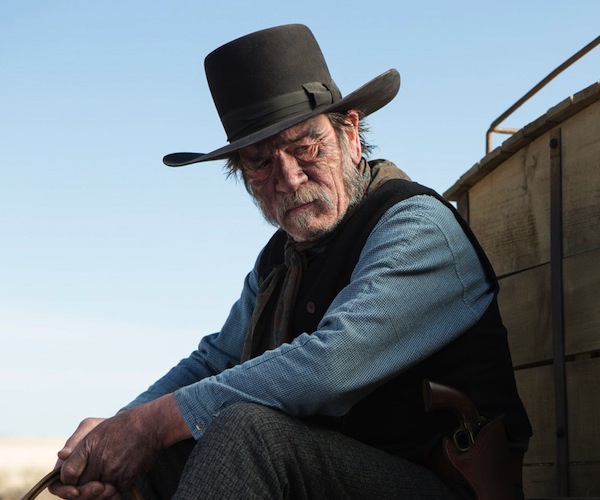Film Review: “The Homesman” — A Western That Rides into Thrilling and Unexpected Places
Tommy Lee Jones’s The Homesman could have been an old-fashioned Hollywood Western. Thankfully, it isn’t.
The Homesman, directed by Tommy Lee Jones. At Kendall Square and West Newton Cinemas.

Tommy Lee Jones in the unconventional Western “The Homesman.”
By Gerald Peary
Be patient for the payoff. Though The Homesman, a western directed by, co-written by, and co-starring Tommy Lee Jones, finally will shine, it’s a mix of good and bad for its first two acts. Starting with the good: the lead character, so very rare for a shoot-’em-up, is a woman. It’s refreshing to have a western story built around a strong, skilled, self-reliant female, rancher Mary Bee Cuddy (Hilary Swank), who can plow, ride a horse, draw water from a well. She can also cook and sing; and she’s the one who invites a cowhand to her ranch and, after dining him, makes a bold proposal of marriage. A typically shallow guy, he answers, “no.” He’s not taken with her unconventional looks, and he’s intimidated by her forthrightness.
Probably, Cuddy is lucky to be so rejected. What we see of actual matrimony is frightening in this claustrophobic settlement in the windy, treeless, the world-is-flat Nebraska Territory. Three young local women have gone stark mad in the years since becoming brides. Isn’t the spooky, gloomy, lonely atmosphere enough reason for their depression and insanity? The filmmakers didn’t think so, and instead supplied shrill melodramatic sequences to explain the craziness of the three wives. One has been raped and abused by her husband, another murders her baby, another’s toddlers succumbed to diphtheria. These scenes don’t work. They are confusing, unpersuasive, overwrought.
Only bachelorette Cuddy seems relatively unscarred. In a frontier community of untrustworthy, passive men, she is the capable one who steps forth for the heroic central journey. She will assume responsibility for these damaged women. She will transport them by mule and wagon from raw Nebraska to a church-sponsored sanctuary in a civilized Iowa town. It’s an arduous trip through unfriendly Indian country (this is the 1850s) and across the wide, threatening Missouri.
Handling a trio of psychotics and protecting them on the range is beyond one person, even Cuddy. Enter grizzled old-timer George Briggs (Jones), her potential second-in-command. Briggs and Cuddy meet cute, when she sights him one day in the countryside with a lethal rope around his neck. She rescues the law-breaking scalawag from being hanged, but only when he agrees to do her bidding: accompany her trekking East to Iowa.
It might be an original plot point, this voyage of insane women. But the novelty of their lunacy wears off. As portrayed, they aren’t the most exciting, or dramatic, company. They sit inside the wagon, tied up and comatose and unable to speak. Escorted outside, they also vegetate on the ground, mostly unaware of who they are and where they’re going. One lost character blends into another, and skilled thespians are wasted, including the talented Australian actress Miranda Otto.
The crazy ladies become mute background for the story of Cuddy and Briggs, which, for a while, is a borrowed familiar one. It’s the river trip from The African Queen transferred to the Nebraska plains: Swank’s bony, bossy, opinionated, Hepburn-like spinster acts condescendingly toward her guide, Jones’s unmannered, mongrel, Bogart-like drifter. But as with Bogey’s Charlie, he proves more skilled and resourceful than she could have imagined, though they bicker and squabble as they cross the range.
The African Queen turned, of course, into an unlikely but sublime romance. I expected much the same from The Homesman, that Cuddy and Briggs would open up and warm up and get together. Emulating the John Huston–directed classic, Tommy Lee Jones would serve up an old-fashioned Hollywood happy ending.
Spoiler alert!
No. Nothing of the sort. For two acts, Jones has set the audience up. Act Three of The Homesman is totally weird, going to thrilling, unexpected places. That’s after a major character ups and dies, throwing the movie completely off its path. What you end up with is what The Homesman promised to be earlier, a deep, very unusual western.
Sorry, feminists, but The Homesman finds itself when it ultimately becomes a guy’s story, when Tommy Lee Jones’s George Briggs—wild, uncoiled—takes over the screen. Was it all an act earlier, when he seems so unfocussed and unambitious, a slacker, a lazy, low-level criminal? Actually, there were intimations that he is more than a declawed old coot when, by a fireside, he launches into disquieting stories of banditry and a joyful killing of Indians. But it’s only toward the end that, like with a Shakespeare villain, his deviltry is unveiled, in an act of vengeance beyond horrible.
The last we see him he’s shooting a gun into the darkness, uncaring if he hits anyone, then dancing a jig and celebrating. In a rare act of honor, George Briggs brought the ladies East. Now, a free man, he’s heading West.
Gerald Peary is a professor at Suffolk University, Boston, curator of the Boston University Cinematheque, and the general editor of the “Conversations with Filmmakers” series from the University Press of Mississippi. A critic for the late Boston Phoenix, he is the author of 9 books on cinema, writer-director of the documentary For the Love of Movies: the Story of American Film Criticism, and a featured actor in the 2013 independent narrative Computer Chess

